
Thanks Ranjini. Jamnagar is quite an offbeat location for people visiting Gujarat and it is an endeavor to bring this glory to those who look for gems of Gujarat.
8,751 views
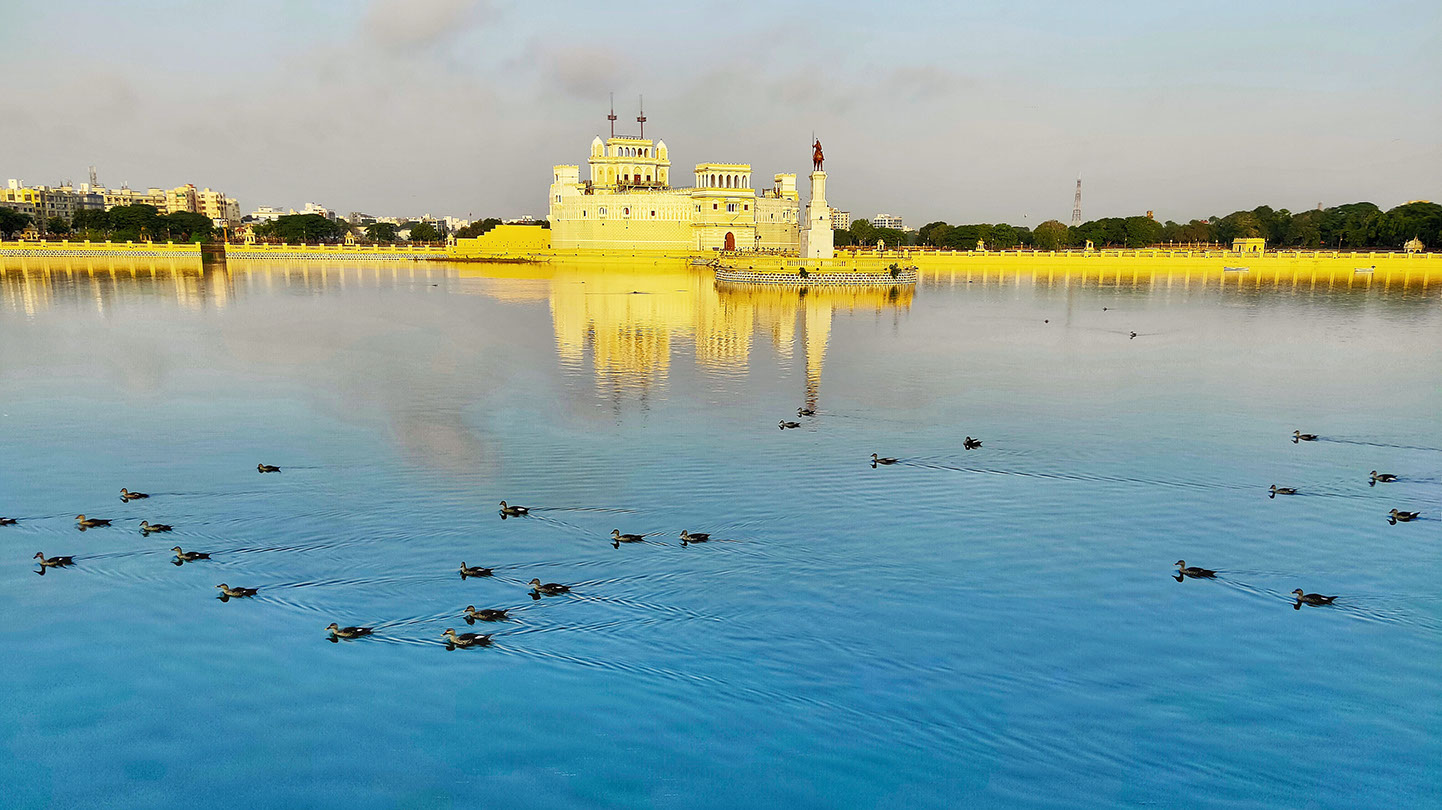
A visit to places that hold childhood memories is always a pleasure and I had an opportunity to do this recently. I visited my hometown Rajkot in Gujarat after a rather long break, thanks to the pandemic. On my way back to Bangalore, I ended up flying out of Jamnagar owing to a canceled flight from Rajkot. Jamnagar holds fond memories of my childhood as I used to spend many of my vacations there at my uncle’s place and this was my chance to relive some of them. While Jamnagar is popularly known as the “World’s Oil City”, this city also offers some of the heritage architecture of Gujarat. The rich and diverse past of this beautiful city is showcased through the ancient structures, temples and natural sites spread across the city which makes Jamnagar sightseeing enriching. It was a truly heartwarming trip. With my passion for travel, I saw this place in a new light and discovered the rich heritage and beauty of Jamnagar.
Jamnagar, earlier known as Nawanagar, is a royal city built by Jam Rava Jadeja around 1450 AD. Being a royal city, the kings of Jamnagar were referred to as "Saheb" (meaning Sir) as a mark of respect. Jam Saheb Ranjit Sinhji was the first Indian cricketer to play international cricket. This led to the start of the famous Ranji Trophy cricket tournament with the trophy named after him. He was a philanthropist who contributed immensely to the development of Jamnagar. Many monuments that we see today are his contribution. Here are some lesser-know facts about Jamnagar, which you might find interesting.
There are many places to explore in the royal city of Jamnagar. Pratap Vilas Palace in Jamnagar is one of the finest and exquisite royal palaces in Saurashtra region of Gujarat. Built by Jam Ranjit Sinhji between 1907 and 1915, the palace is a blend of Indo-Saracenic architecture laced with European architectural inspiration. The highlight of this palace is the three glass domes which is a replica of Victoria Memorial building in Kolkata. The ornate pillars with carvings of flowers, leaves, birds, and animals enhance the aesthetics of the palace. The walls of the magnificent halls of the palace are adorned with artefacts of that period including portraits, swords and armors.
The palace is embraced by spacious greenery which was converted into a Natural Park in 1968 by Maharaja Kumar Ranjit Singhji. The Gujarat earthquake of 2001 has damaged some sections of the palace but the grandeur and pomp of that period is still very evident. The palace is not open to the public and special permission from Darbar Gadh is required to visit, and even then all areas cannot be accessed. It is definitely one of the places to visit in Jamnagar. Unlike Laxmi Vialas Palace in Vadodara and Nilambag Palace in Bhavnagar, this palace is not accessible to tourists from within.
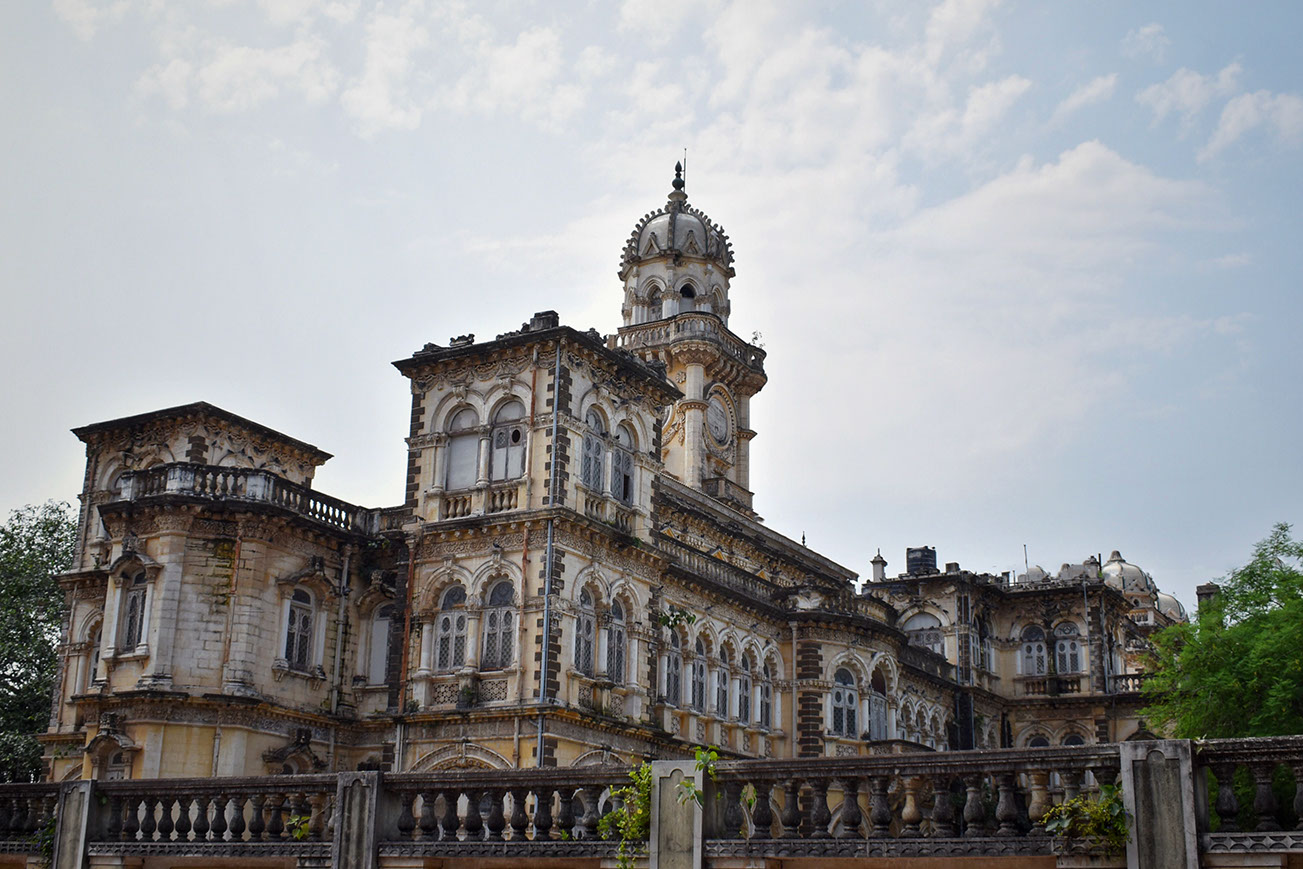
Pratap Vilas Palace Jamnagar, a perfect amalgamation of eastern and western architectural styles
Darbargadh Palace is another significant historical monument in Jamnagar which was the royal residence of Jam Sahebs. The original palace was built in 1540 but extended over the years into a magnificent building. The unique architecture displayed an incredible blend of Rajput and European styles. The 2001 earthquake took its toll on this structure leaving only the outer periphery. This iconic monument is ironically now a market where local artefacts and the famous Bandhani (tie & dye) fabrics are sold.
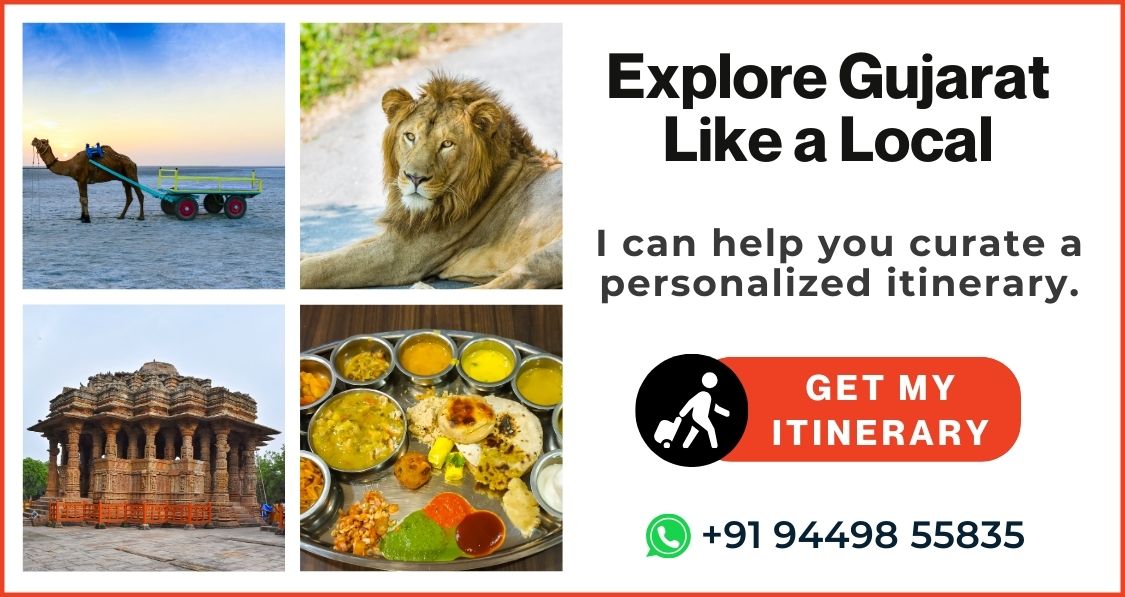
Walking through the remnants of this historical building was like wandering through a lost city that was once glorious and regal. The history of the place came alive as I walked through the courtyards. The walls showcased beautiful paintings, sculptures, stone carvings, and fretwork, some of which date back to the 8th century. Darbargadh Palace is like a museum adorned with exquisite architectural wonders, and it is a must visit in Jamnagar.
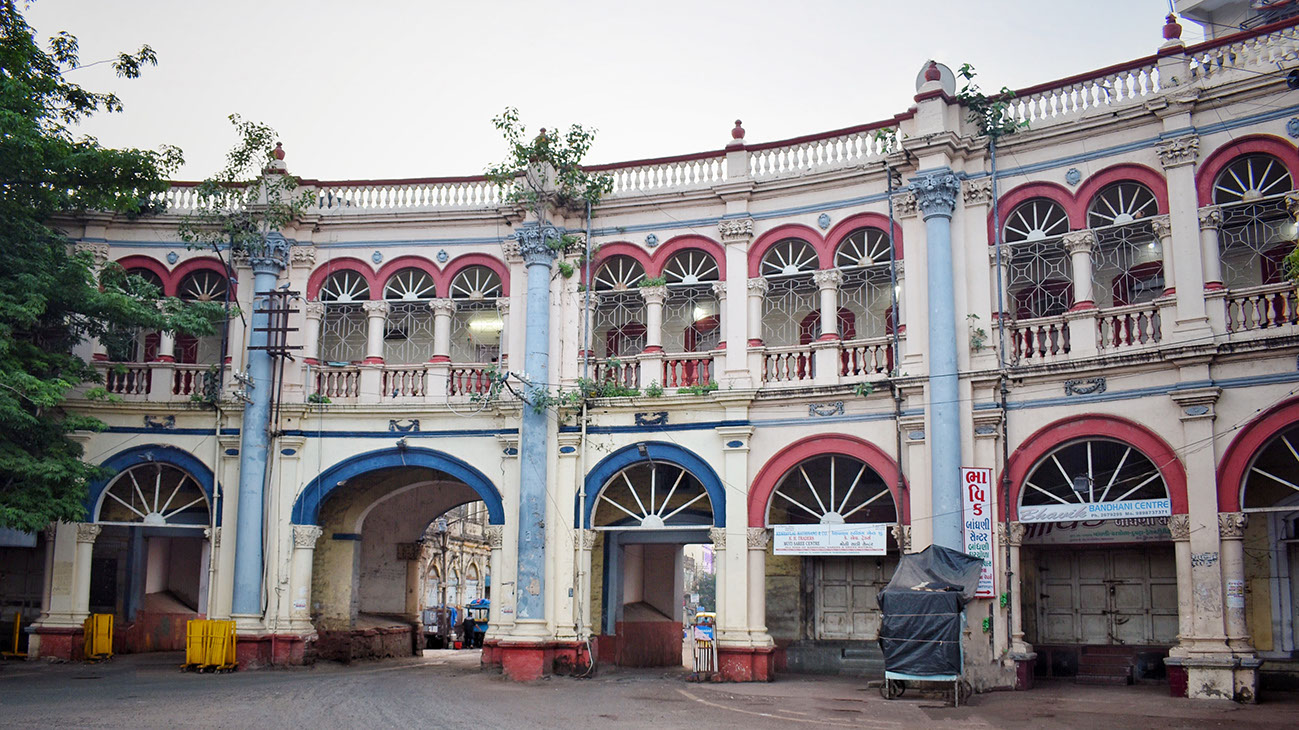
Darbargadh Palace is the most iconic building in Jamnagar, a masterpiece of architecture and history
Jamnagar is famous for oriental studies and rulers of this state patronised Ayurveda since early days. During the reign of Jam Saheb Digvijay Singhji in 1940's, Dr. P.M. Mehta, a great learner and visionary, was the court physician. He convinced the king and queen to establish a center for Ayurvedic Studies and thus Shri Gulabkunwarba Ayurvedic Society was established in 1940. In 1944, a magnificent building was constructed through the patronage of the King of Jamnagar and other wealthy persons which was named "Dhanvantari Mandir". There is a temple here dedicated to Lord Dhantvantari in Moti Dhanej Village of Junagadh District. It is believed that this was the village where Dhanvantari, Physician of Gods and father of Ayurveda passed away. Wandering through the vast campus, I was truly fascinated by the progressive thinking and planning of the kings of Jamnagar.
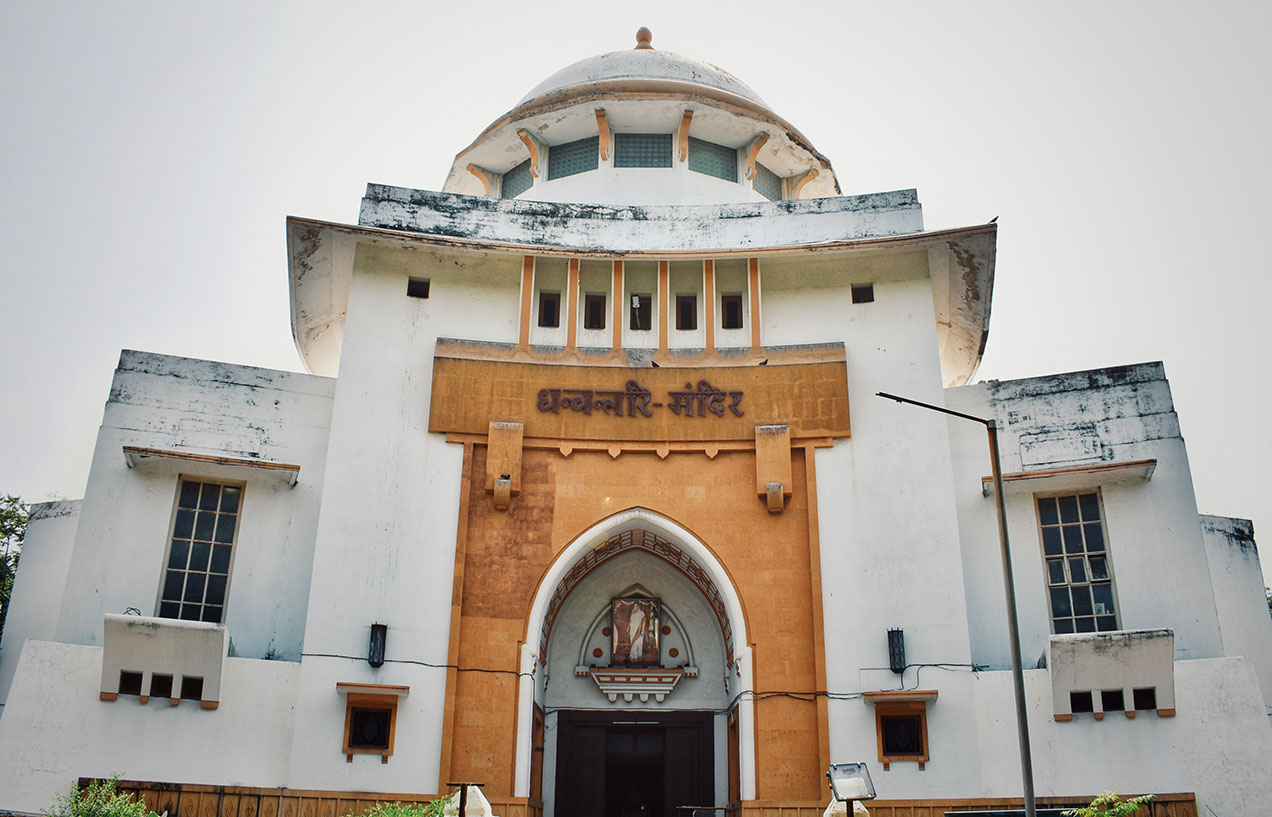
Dhanvantari Mandir is dedicated to the God of Ayurveda and aptly named after him
Housed in the palacious building of Dhanwantari Mandir is Shri Gulabkunwarba Ayurveda University founded on 1st July, 1946. The university has a sprawling campus with spacious classrooms and excellent infrastructure. Undergraduate and postgraduate courses are offered with national and foreign students from various countries of Asia, Africa, Europe and Latin America attending these courses. Within the campus, there is an interesting museum that visitors enjoy. A well-equipped hospital offering specialized Ayurvedic treatments is also a part of this sprawling campus. Well established herbal gardens add to the beauty of the place and the aroma of the herbs was truly refreshing.
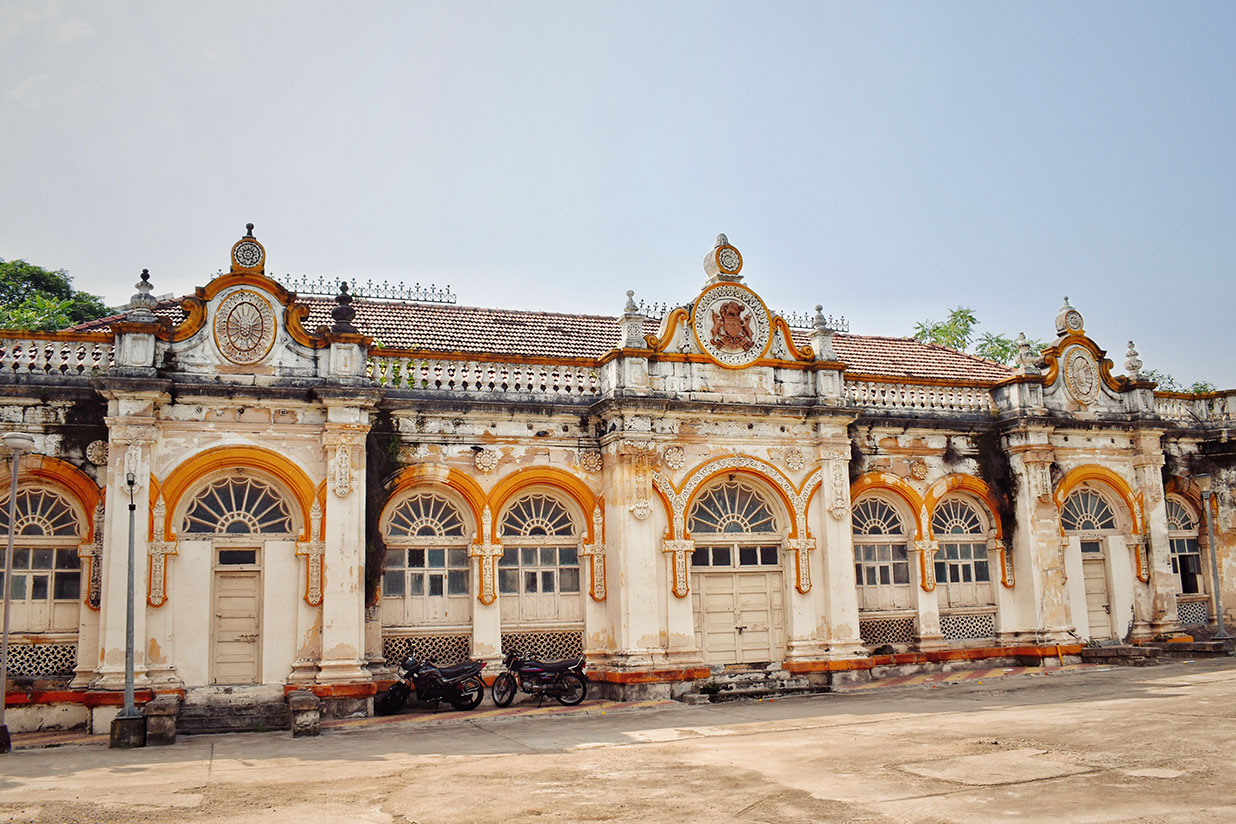
The heritage building of Ayurveda University - a masterpiece of architecture of Gujarat
Chandi Bazar ("Chandi" means silver) in Jamnagar has the Jain Temple Complex that houses the Adinath Temple among others. It is one of the most sacred places to visit in Jamnagar. Built between 1574 and 1622, this temple has religious as well as historical significance. The exterior looks humble yet beautiful. Devoted to Adinath, who is said to be the first Jain Tirthanker, his story is beautifully depicted inside the temple through stunning and vibrantly colored paintings. Strolling through the temple, I was reminded of the game of Pictonary, in which words had to be guessed by drawing pictures. These artists seemed to be experts! Although the ravages of time have dimmed the brightness of the colors, the spiritual aura of the place is very tangible. The skilled craftsmanship of the artisans is visible in the intricate carvings adorning the ceilings, pillars and walls of the temple. The main temple is surrounded by 52 small temples.
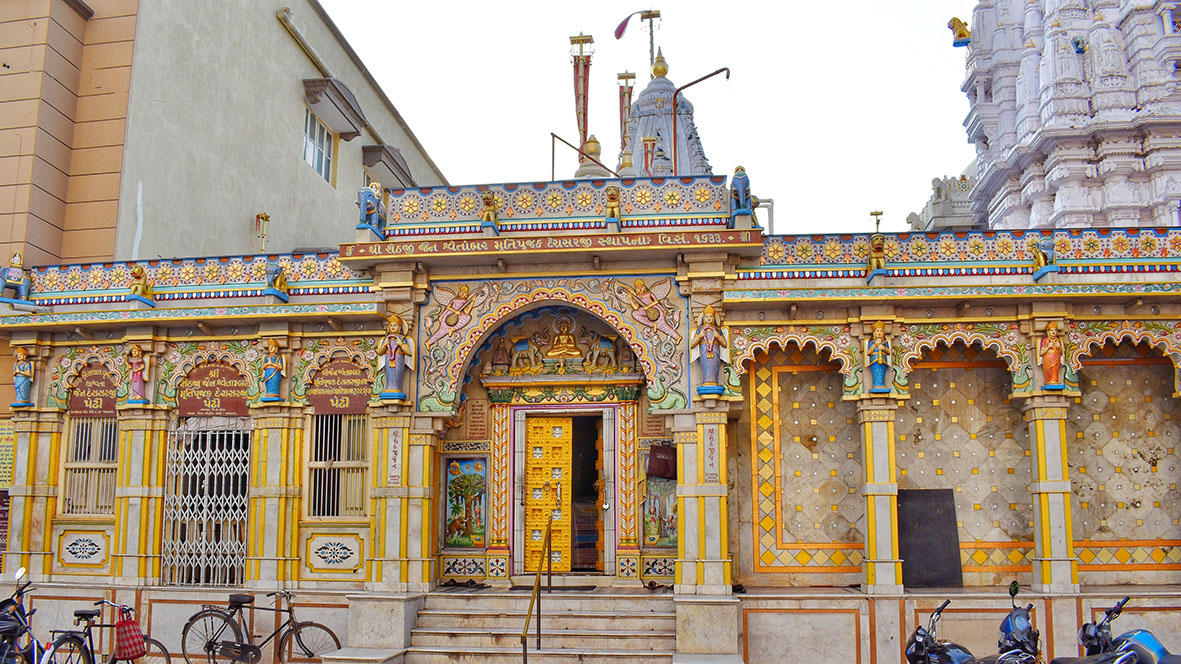
Dedicated to Adinath, the vibrant colors of this 400-year-old temple is a big attraction in Jamnagar
Jam Saheb Ranjitsinhji was a progressive thinker and this is evident through many things he did during his rule. One of the many amazing structures commissioned during his time was the Solarium also known as the Ranjit Institute of Poly-Radio Therapy. Built with French architecture in 1934 by Dr. Jean Saidam, it is one of its kind in all of Asia. The solarium stands at a height of 40 feet above the ground. It has a glass tower that revolves 360 degrees to harness sunlight all day long for treating skin diseases. Sunlight, a natural source of energy, has immense healing power which is stored in the Solarium and was used for treatment. The last solar therapy was administered in 1996 and it is currently nonfunctional. Out of a total of 3 solariums in the world, 2 located in France were destroyed during world war II. The Solarium in Jamnagar is the only one that exists across the world and is a MUST visit place. It is unfortunate that this place is not mentioned anywhere in the Jamnagar city guide. I belong to this amazing land of Gujarat and it makes me feel truly proud!
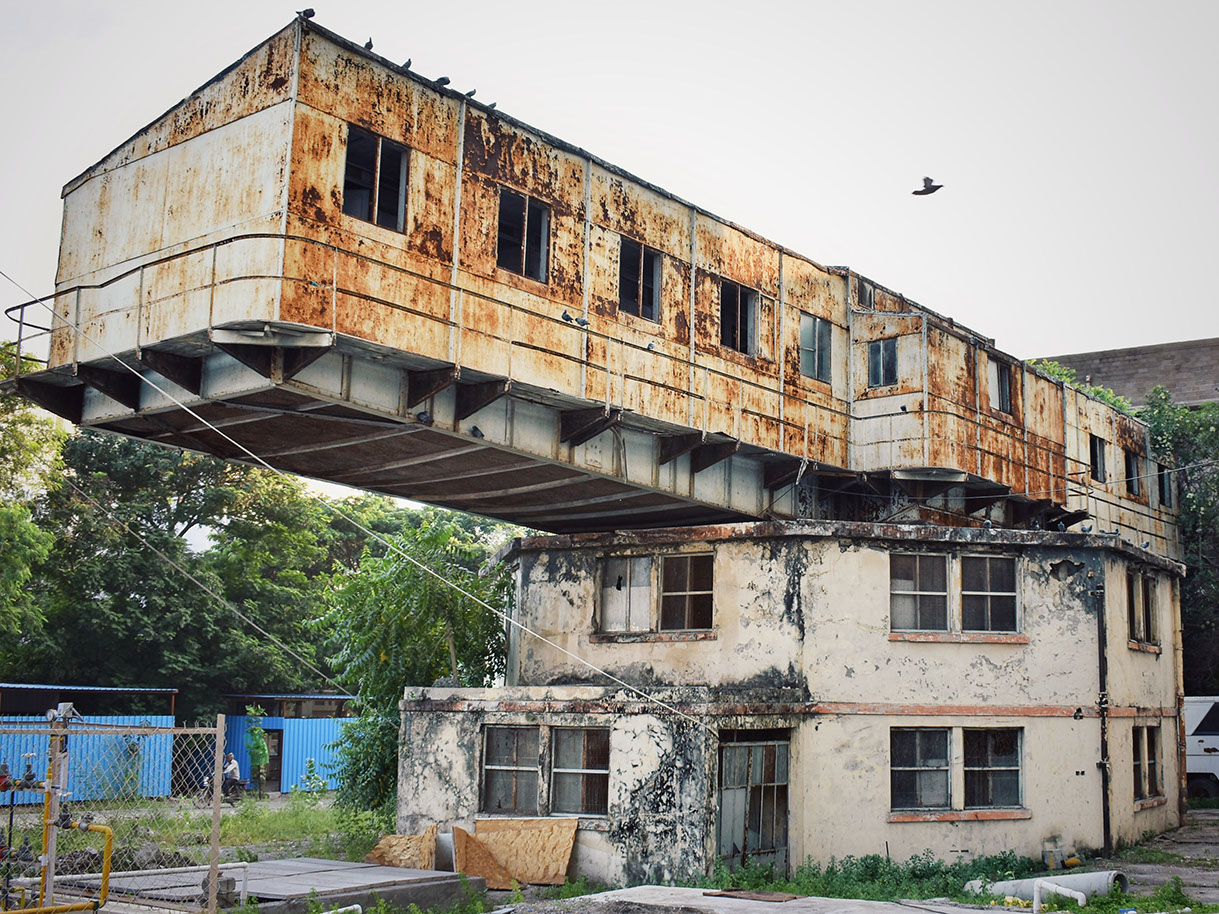
This Solarium with a unique revolving tower is the only one in the world existing today
In India, cricket is more a culture than a sport. Anything even remotely linked to the game draws enormous followers and I am no exception. Ajitsinh Pavilion is a historical place to visit in Jamnagar. Considered a heritage site, Ajitsinh Pavilion was constructed in 1908 by Maharaja Ranjitsinhji who was a cricketer himself. The first match hosted here was in 1933 which was a prestigious accolade for Jamnagar and Gujarat. Many world class players were coached in this iconic stadium. It got a facelift in 2013 by the Government of Gujarat. It now has a Sports Coaching Centre with practice pitches and a capacity of 20,000 spectators. The vibe of this place is exceptional and I strolled around for a while immersed in the ambience.
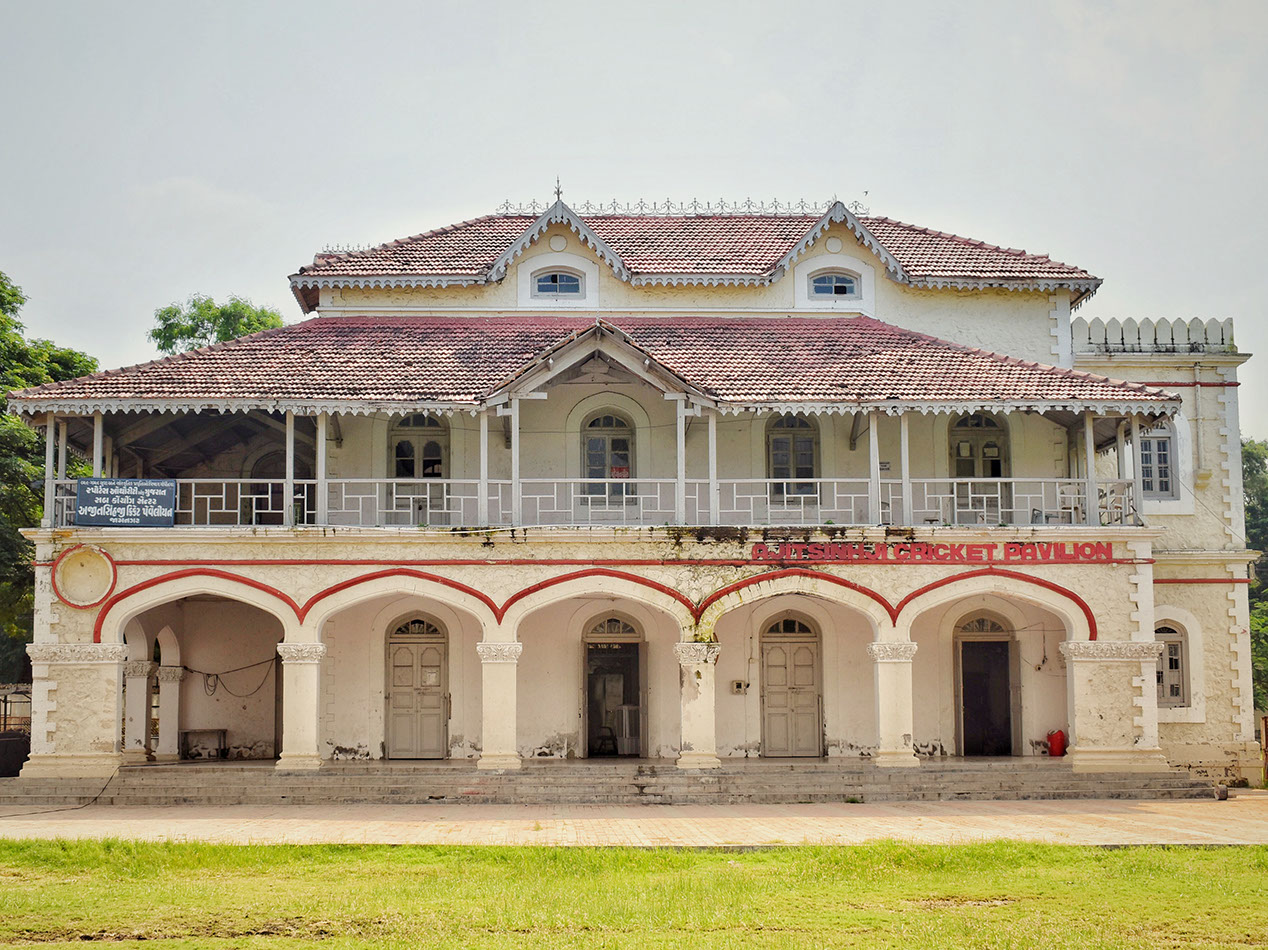
Ajitsinh Pavilion is an iconic heritage site and very significant in cricket history
Possibly the favorite spot of visitors and locals alike, Lakhota Lake is one of the most famous lakes in Gujarat and a serene place in Jamnagar. This lake is manmade and surrounds the exquisite Lakhota Palace which were both constructed by King of Navanagar, Jam Ranmal Saheb II in the mid 19th century. Situated in the middle of the city, it is a picture perfect spot to spend time in natural surroundings and relax. There is a walking track around the lake that attracts walkers in the morning. I arrived there around 7 am, to witness the Lakhota Palace and its surroundings glisten like a gold building. This is because the sun's rays do not fall on the lake owing to the canopy of trees around it. It was a truly incredible sight, one you should not miss if you are an early riser.
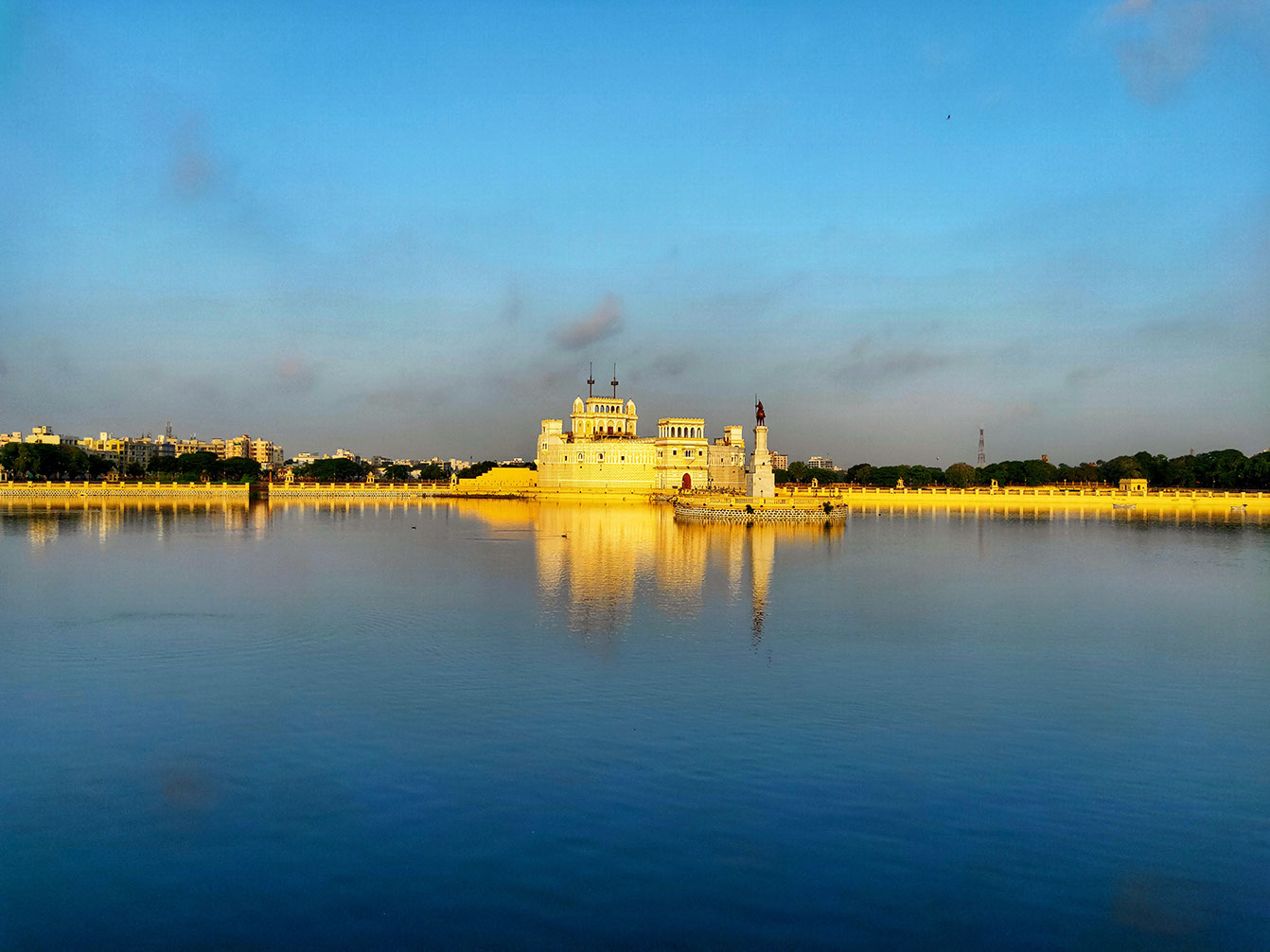
The stunning view of Lakhota Palace at dawn with a sprinkle of the sun's rays giving it a shimmery golden hue
While the view of the Lakhota Lake is gorgeous during dawn, the view of the lake at night during the weekend is a spectacle with the dazzling lighting. It is the perfect place to have a relaxed evening while enjoying some local Gujarati street food served at the many food stalls along the path. There are benches surrounding the lake where visitors can sit and enjoy the ambience. The lake also has some ornate gazebo-like structures that make for elegant seating options for visitors. I indulged in some delicious local street food which brought back beautiful memories of carefree days spent here.
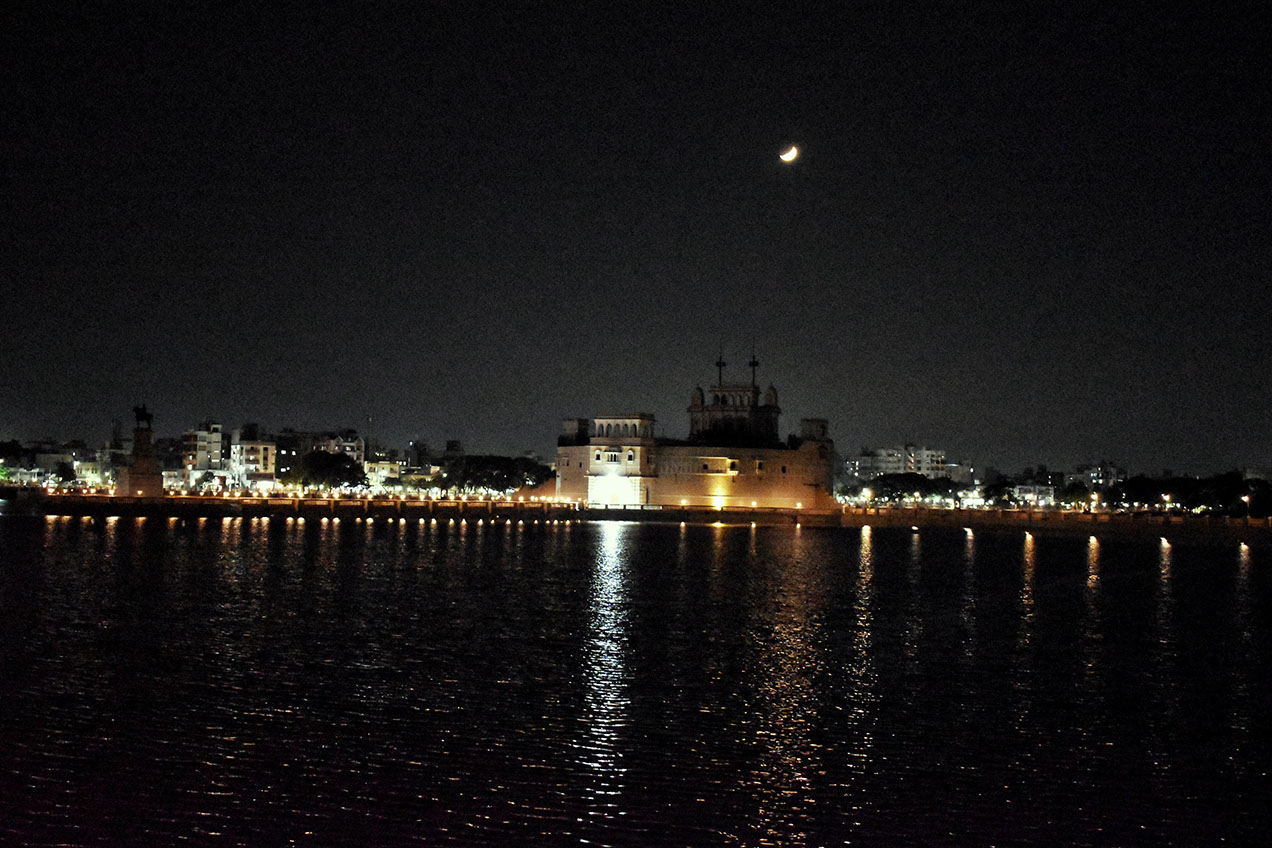
Night view of the Lakhota Palace and Lakhota Lake
While the Lakhota Lake itself is a delightful place, the Lakhota Palace which was earlier a fort, is a masterpiece. In the ancient era, it served as the fortified area of the dynasty providing security to the rulers. The structure was built in Rajputana style with Iranian influence. Known as Lakhota Kotho, it covered an extensive area of 3,000 meters square. Besides the palace, the Derani-Jethani Memorial is also an interesting structure with a heartwarming story. The exquisitely carved wooden verandahs, wall paintings and stucco work showcase the exemplary craftsmanship of that era. The palace houses an archaeology museum which exhibits unique and ancient artefacts like sculptures, firearms, and medieval pottery.
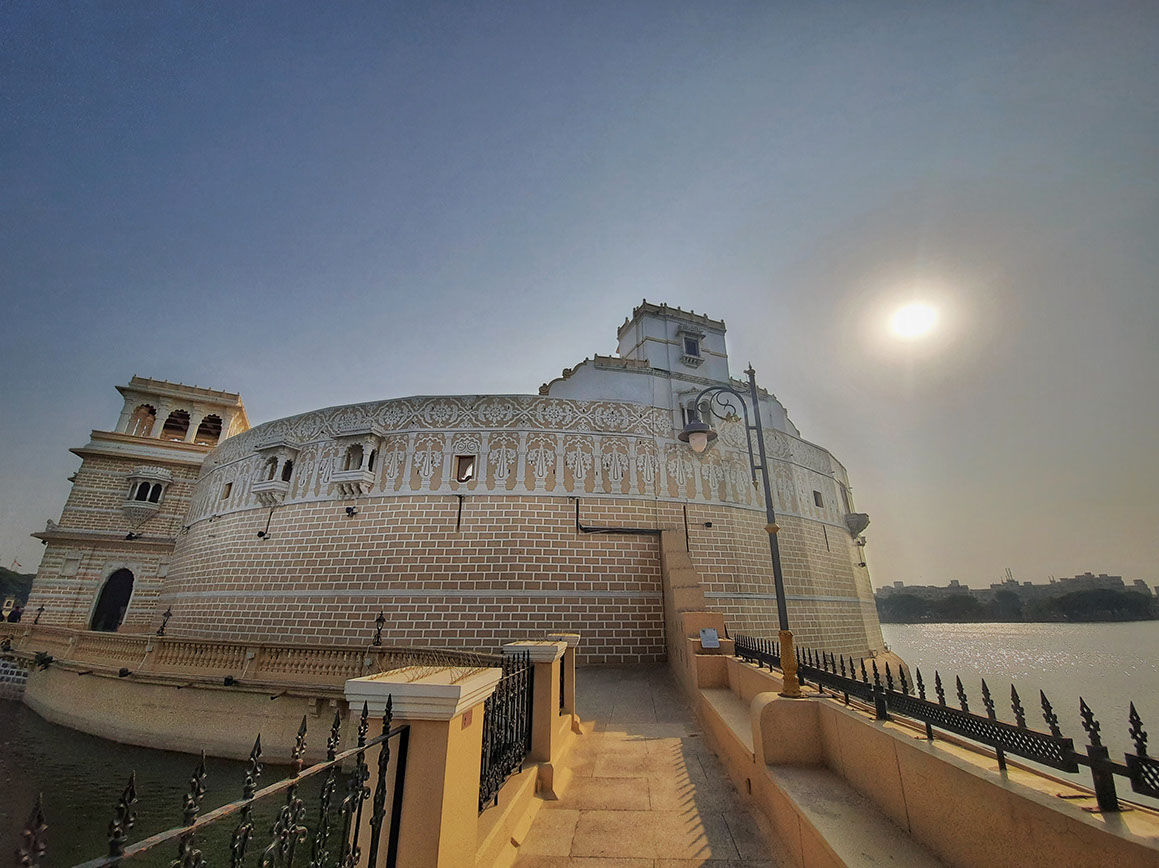
The intriguing Lakhota Palace and Museum is a masterpiece architecture of Gujarat
An interesting feature of the Lakhota Talav is the Jharokhas (pavilions). Jharokhas are ornately designed sit-outs that overlook the centerpiece, the Lakhota Palace. A significant feature of Rajput architecture, they were designed as an enclosed balcony or stone window, mostly canopied, adding an aesthetic dimension to palaces. There are 12 Jharokhas placed in the periphery of the lake, which are round and rectangular in shape. These pavilions served as strategic viewpoints and the structures are very attractive because of the excellent construction and architectural techniques.
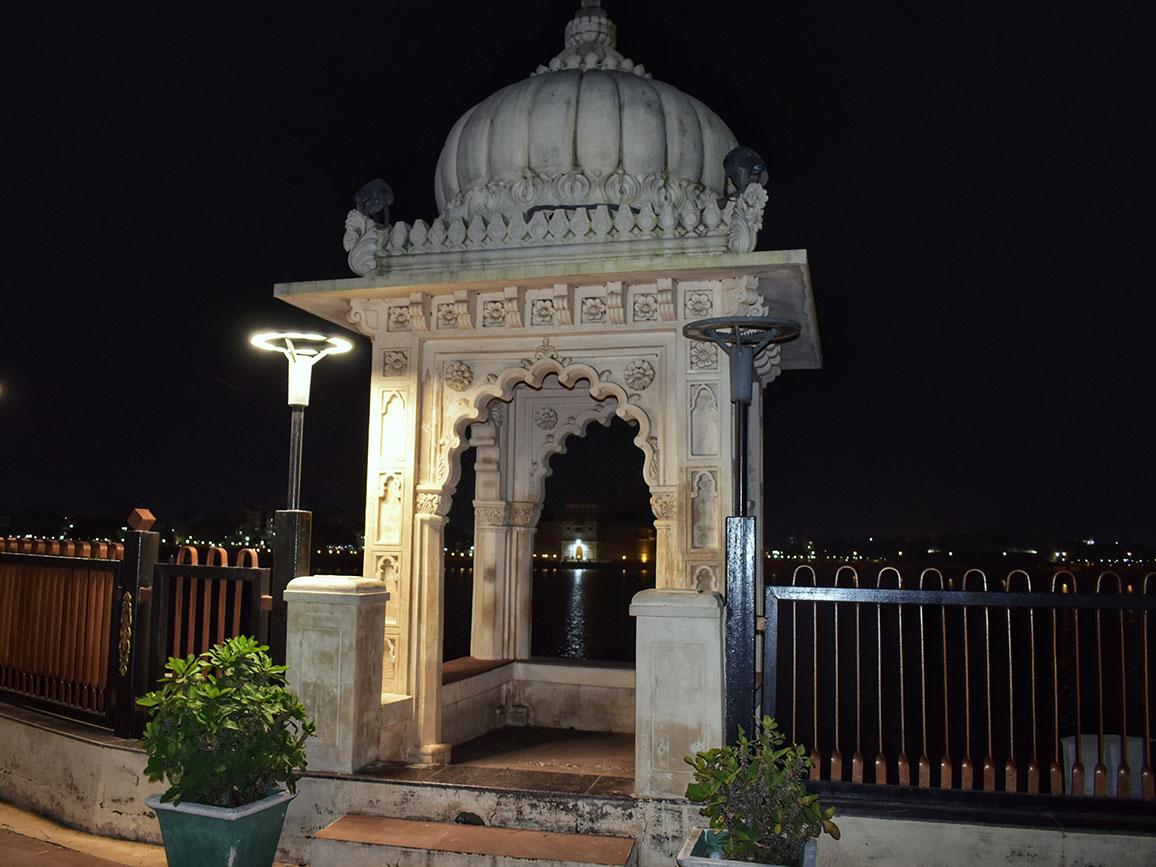
These ornate Jharokhas speak volumes about the grandeur of the Jam Sahebs of yesteryears
Also called Ranmal Lake, Lakhota Lake is famous for birdwatchers and nature lovers in Jamnagar. Around 75 species of resident and migratory birds, such as flamingos, gulls, pelicans, spoonbills are known to be regular visitors here. While Lakhota Lake itself is beautiful, there are some interesting places around that are worth visiting, especially the Khijadia Bird Sanctuary in Gujarat, which is about 14 km from the city. Narara Marine National Park and Pirotan Marine Park are famous for undertaking a 'coral walk' as the tide ebbs at the coast. During this trip, I did not visit due to time crunch, but they are definitely places to visit if it is your first visit to Jamnagar.
A rather medieval looking red building catches one's attention while wandering through Jamnagar. This happens to be a palace constructed by the Maharaja of Nawanagar, Jam Saheb Vibhaji. Called Vibha Vilas Palace, the simple facade and stucco decoration painted in red is evident of the colonial impact of that era. The interiors of this magnificent palace are elegant with ornate ceilings, attractive lighting and wooden staircases.
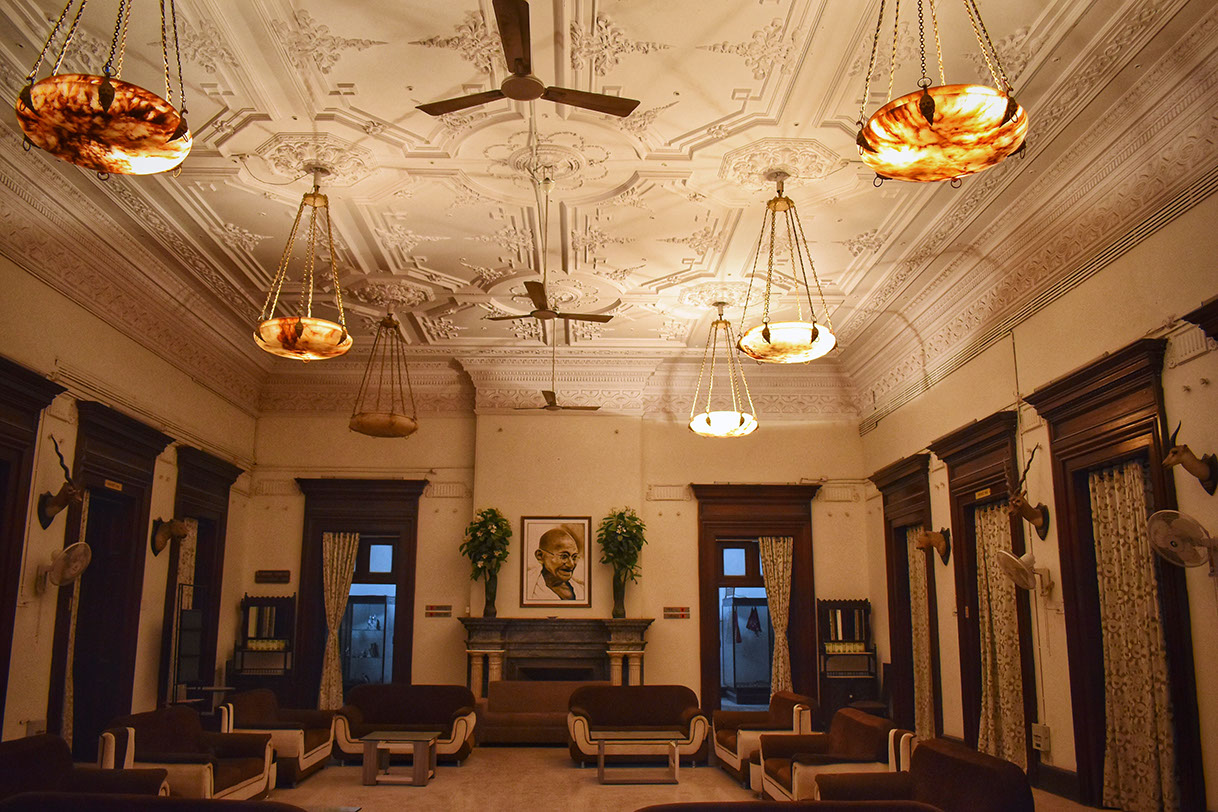
Circuit House displays the splendor and opulence of the Maharajas of Jamnagar
Stuffed animal heads are also displayed as wall decor to show off the hunting skills of the Jam Sahebs. The 2001 earthquake destroyed one side of the building completely. It is, at present, being utilized as Circuit House (Guest House for the Government Officers). It is also known as Lal Bungalow due to its red color. It is not available for private bookings, however there are a number of hotels in Jamnagar to suit every budget.
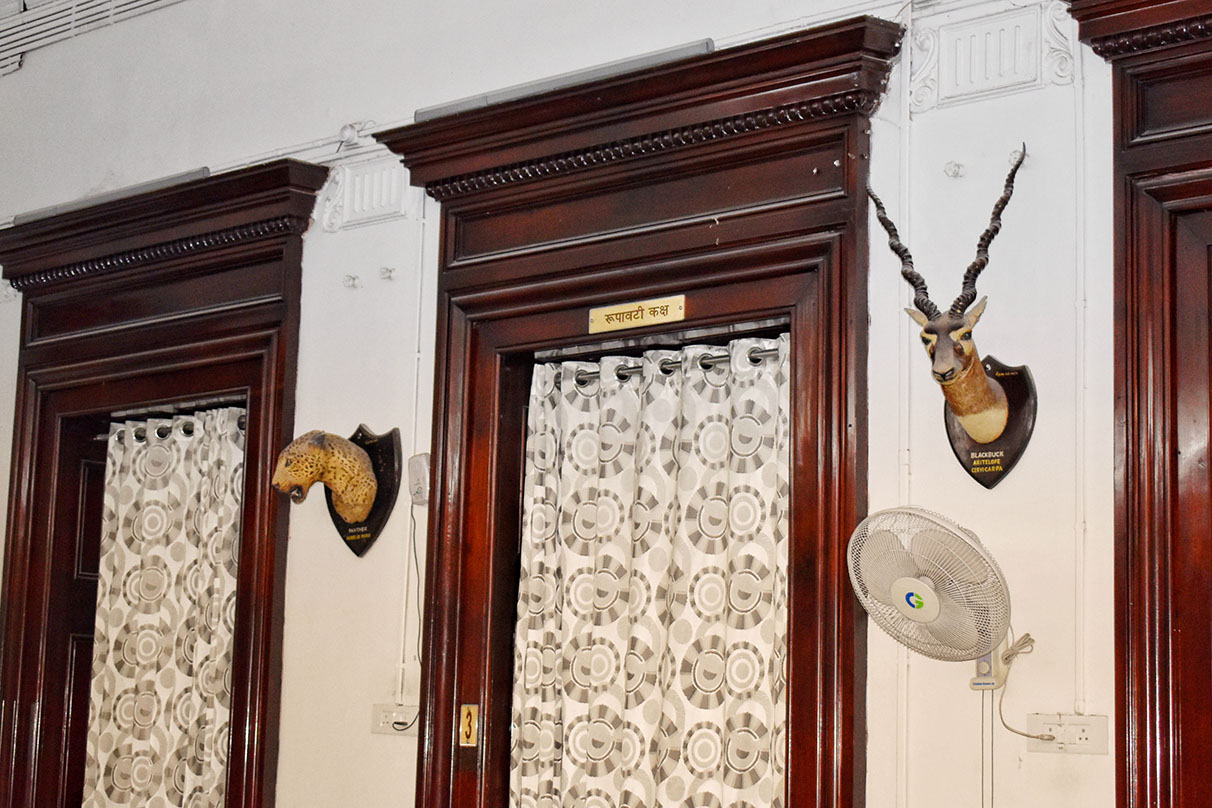
The interior of Vibha Vilas Palace is decorated with the 'trophies' captured by the Jam Sahebs
The first mosque to be built in Jamnagar was during Aurangzeb's rule. In 1664, Qutbuddin attacked Jamnagar with his army and looted it. During this attack, His Highness Jam Saheb Raisinhji died. The mosque was built as a mark of Qutbuddin's victory. This mosque was later beautified and made bigger and named Jumma Masjid. His Highness Jam Saheb Vibhaji's muslim wife Dhanbai further enhanced the mosque giving it its current avatar. Although this mosque has a different architectural style, it is similar to Jami Masjid in the walled city of Ahmedabad.
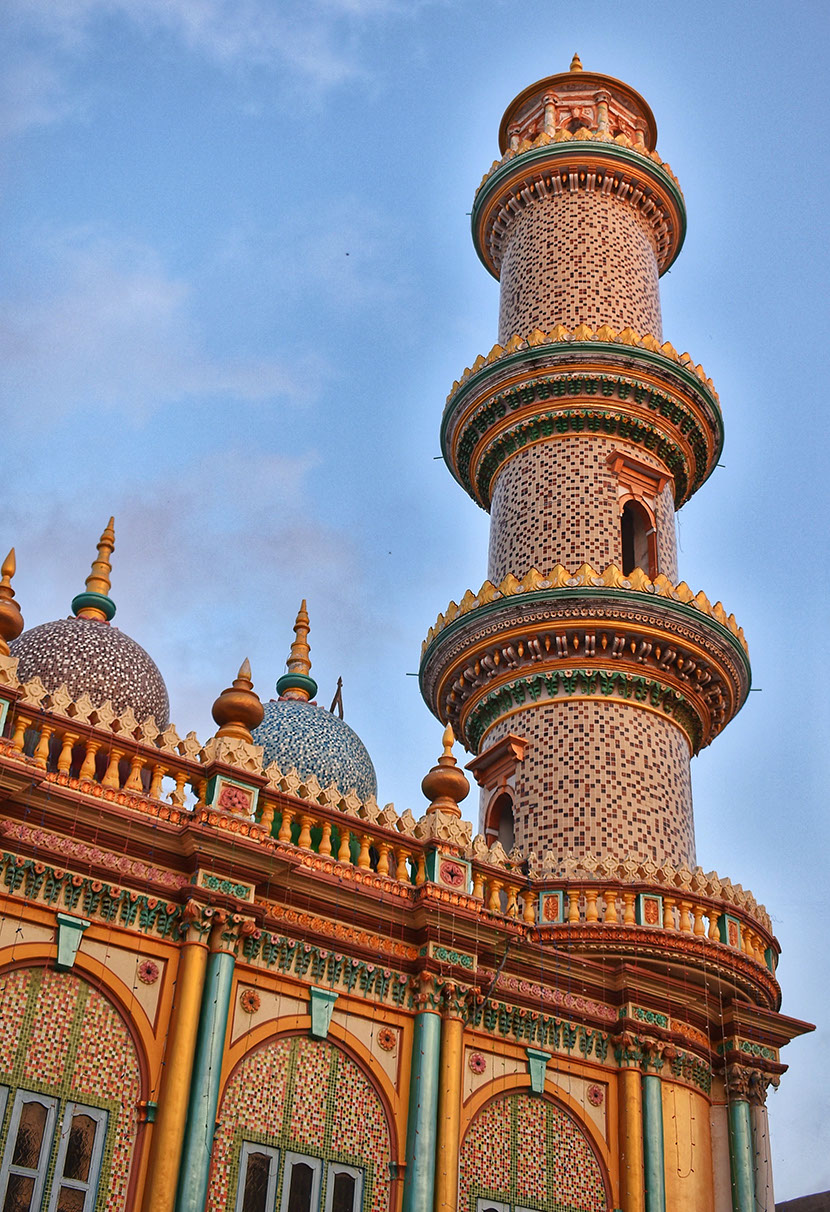
The vibrantly colored minarets with intricate carvings showcase the extraordinary craftsmanship
Clock towers are a common sight in cities across the world and Jamnagar is no different. The Mandvi Clock Tower is an impressive structure that stands proudly in the Chandni Chowk area. Built in the 17th century by Wazir Meraman Khawas, its purpose was to make Jamnagar a walled city and safeguard it from invasion. It houses a turret clock with more than one clock face. While its current avatar is far from what it looked like in the yesteryears, it is an iconic structure in Jamnagar.
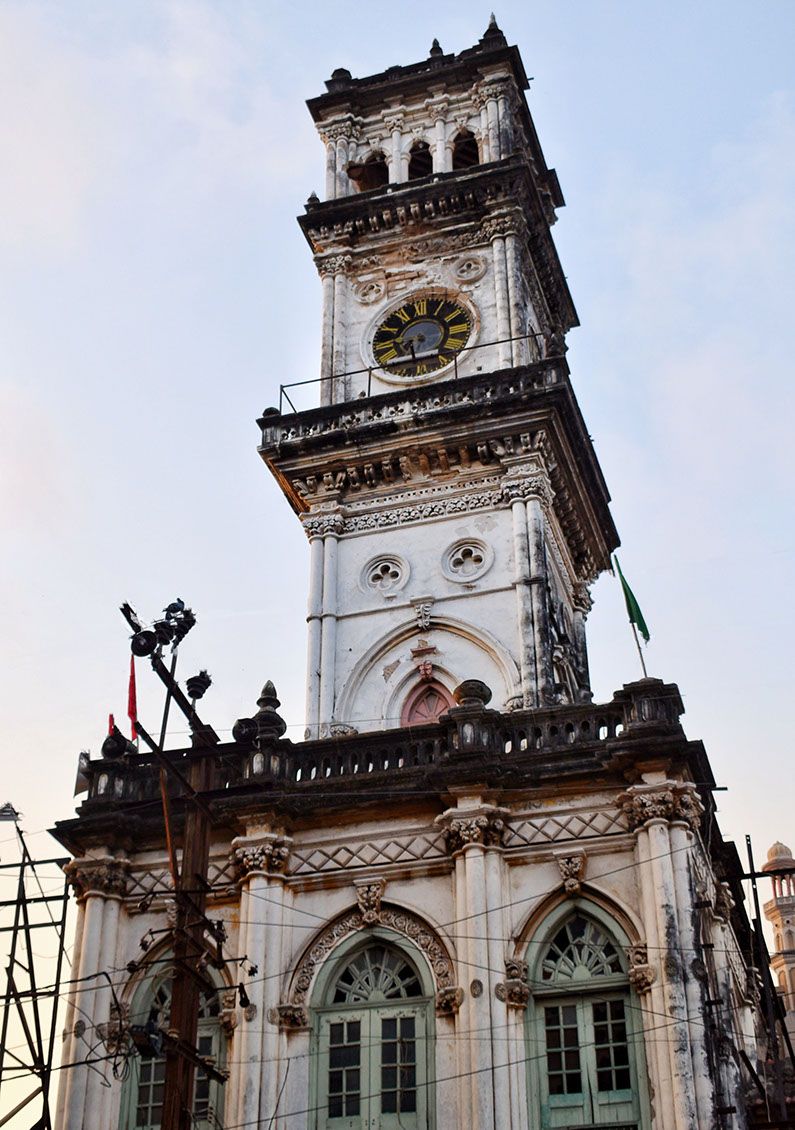
The tall, iconic Mandvi Tower with a vintage clock and an arched doorway in the old city of Jamnagar
The Jamnagar city gates are attractive architectural masterpieces built in the 17th century by Wazir Meraman Khawa. One of the two remaining city gates of Jamnagar from that period is the Khambhaliya Gate. It reminds me of my visit to Vadodara, which has several gates built by the early rulers. The Khambhaliya gate commemorates Raja Jamraval of Jamnagar. This was a defensive structure lying on the fort wall built in the mid 18th century. It was the southern west gate among the five gates of the old fortified city of Jamnagar. It is not only a protected monument but is the last gate standing as evidence of the bygone era. The government of Gujarat has recently restored this heritage site to its former glory. The ornate carvings and architecture speak volumes about the skill and expertise of the bygone era.
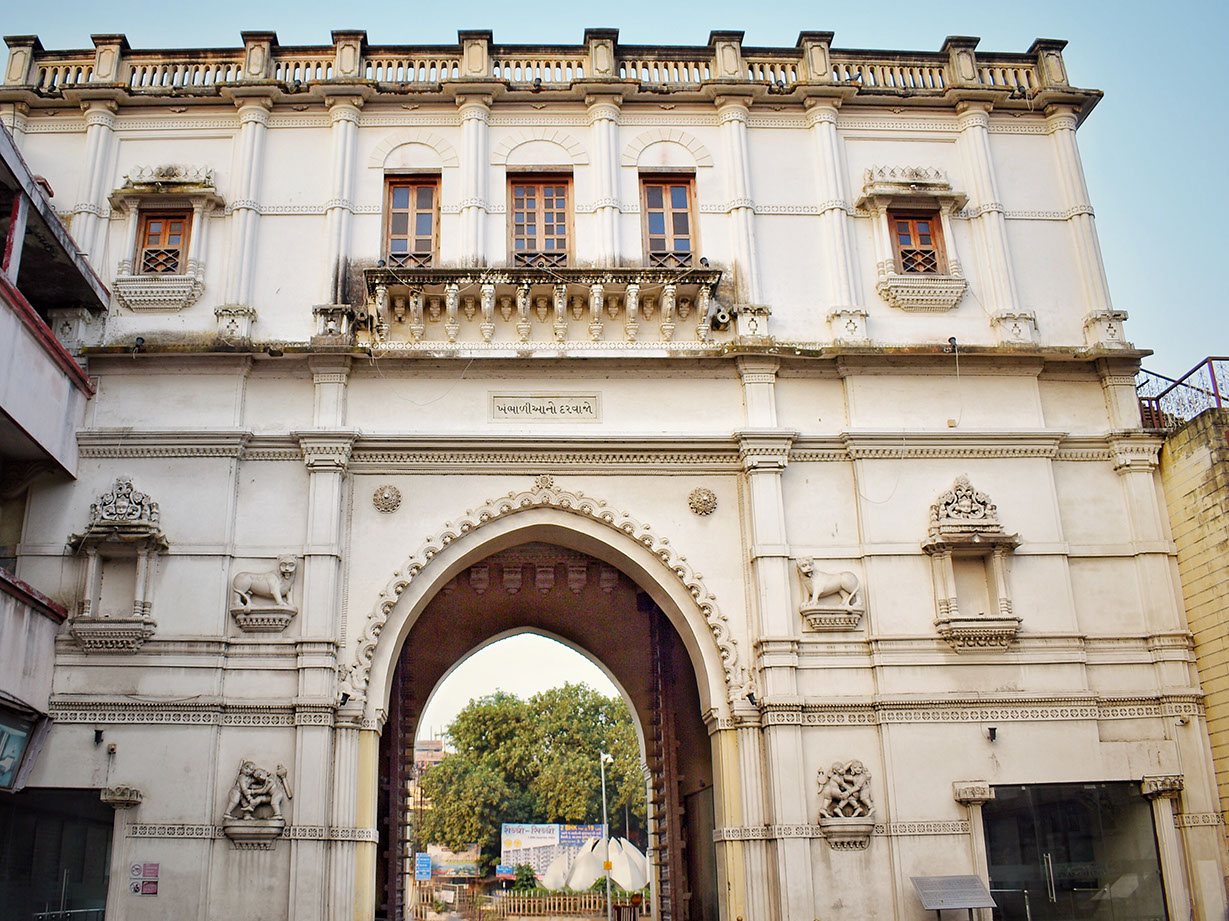
The exquisite architecture of Khambhaliya Gate is the curtain-raiser to the numerous architectural masterpieces within Jamnagar
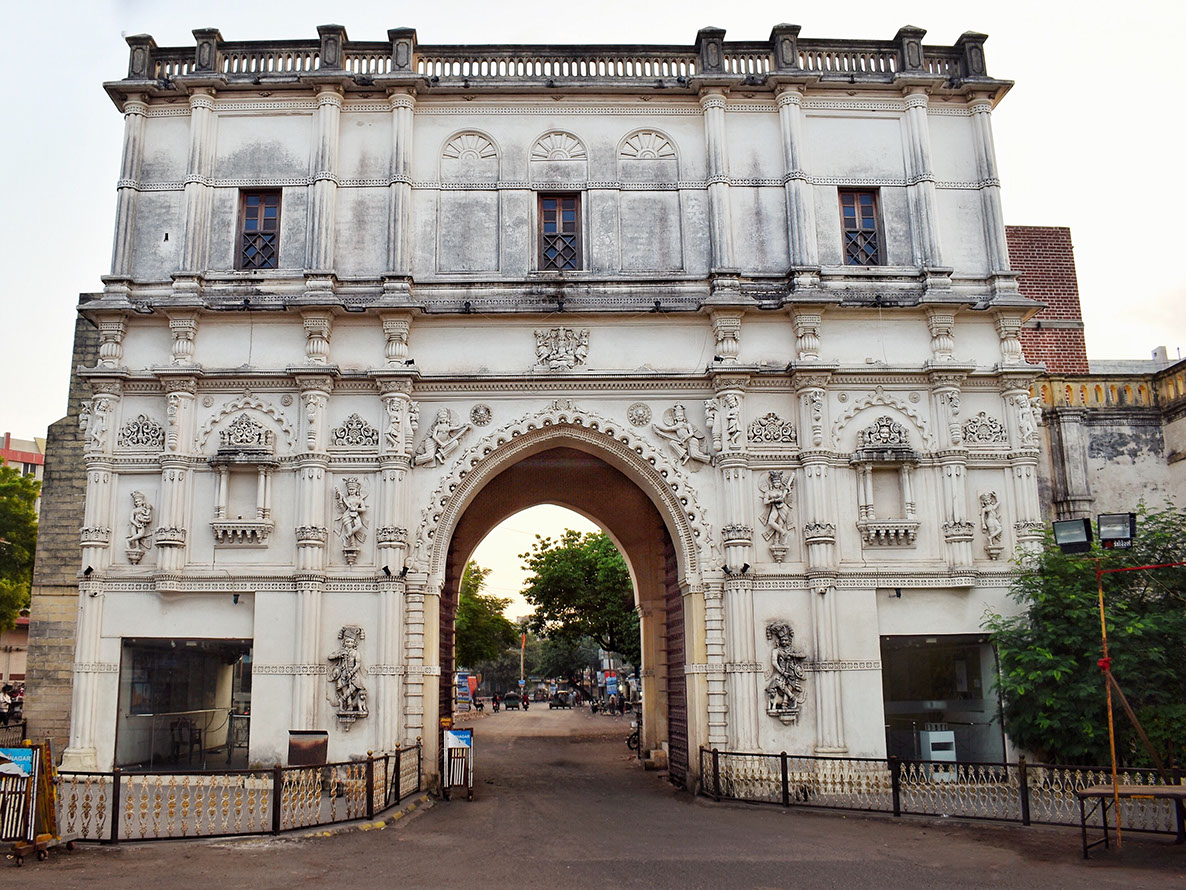
The back of the Khambhaliya Gate is as ornate and beautiful as the front
The city of Jamnagar displays royalty and grandeur. It is endowed with invaluable heritage sites that embody the rich history and culture of the Jams of Jamnagar and their progressive thinking. While taking in all the pomp of a glorious kingdom, do not forget to indulge in the delicious local cuisine. Of course, satiate the shopaholic in you by purchasing the local handicrafts especially the bandhani (tie & dye) garments. All in all, for me, it was an amazing experience to relive my childhood days and of course appreciate the treasures of this beautiful city of Jamnagar. I boarded my flight to Bangalore feeling nostalgic and a sense of pride to belong to this magical land of Gujarat.
Why is Jamnagar famous?
While Jamnagar is famous for the world's biggest oil refinery, it also boasts of some of the most historically and culturally rich monuments.
What kind of place is Jamnagar?
One of the largest cities in the western region of Gujarat, Jamnagar is located on the coast of the Gulf of Kutch. Dotted with monuments of Rajput architecture, Jamnagar is Gujarat's lesser-known gem.
What can I buy in Jamnagar?
Jamnagar is most popular for Bandhani (tie & dye) fabric. Besides that, brass is also famous here. It's the perfect place to satiate your retail therapy pangs!
Who is the king of Jamnagar?
The current king of Jamnagar is H.H. Jamsaheb Shatrusalyasinhji Digvijaysinhji Jadeja, a former first-class cricketer and the last person to hold the title of Maharaja of Nawanagar.
Disclaimer: This blog may contain affiliate links. At no extra cost to you, we may get a small commission if you buy anything. All products and services we endorse have been personally used or come highly recommended to us. These incomes allow us to keep the community supported and ad-free.

This is such a detailed story about a fascinating offbeat destination. Definitely will draw travelers to Jamnagar for its rich heritage.

Thanks Ranjini. Jamnagar is quite an offbeat location for people visiting Gujarat and it is an endeavor to bring this glory to those who look for gems of Gujarat.
This is crazy!! I have been visiting Jamnagar for a very long, Almost yearly once I have been to a few places because my mom loves bandhani so we visited nearby places. Now I have noted a few places from this article that I love to visit and I will be visiting all places. And I want to say the photo of Darbargadh is pretty good I never seen this place like this :)

That's because I visited Darbargadh early morning :) Jamnagar is a heritage city, its quite unfortunate that it has not hog the limelight yet.
Name
Email
Comment